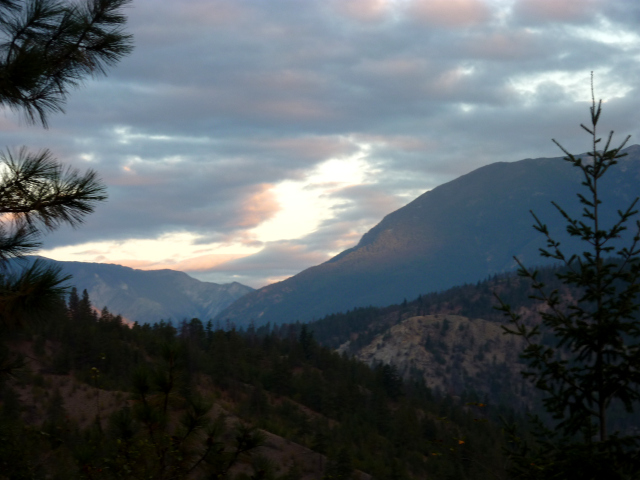Decades ago when I first discovered Canadian fiction, I read Swamp Angel by Ethel Wilson with happy recognition. Back in the 1970s, I wasn’t accustomed to seeing familiar scenery in novels; characters all lived elsewhere. So when the fictional Maggie Lloyd got off the bus at Kamloops and hitched a ride into the hills to a fishing camp, I was delighted. I could actually visualize her journey clearly and recognized the names of the small towns she traveled through. Our family had camped at Paul Lake near Kamloops, and we had driven the Princeton-Hope Highway, back before the Coquihalla Highway made straight the wilderness of the Fraser Canyon.

Maggie’s confidence—“I know this all and I know how to live here”—was also familiar. That’s how I feel whenever we drive into Jasper, Alberta. I recognize every bend in the road and can name most of the mountains, thanks to summer jobs in Jasper when I was a university student. I had walked its streets many times and hiked up whatever slopes were accessible in a day off. Ever since, driving into Jasper has felt like coming home, though buildings change, and Mt. Edith Cavell loses a glacier and rearranges the landscape. I love that place. When I’m there, I can barely imagine my real home in Saskatoon.

That whole puzzling business of being “here” rather than “there”. . . . How do place and memory connect? And what has the connection to do with who I am? As I pack up camping gear, I tell myself, “In two days, I’ll be in Wapiti Campground.” It seems unbelievable. Then three days later, breathing the wondrous mountain air, shivering in the evening coolness, my home seems remote, as if back there, I was someone else, not this woman who now sips her hot tea and watches the elk wander past.
Am I the only one who runs up against that disconnect, I wonder? How do frequent travelers cope? Those who go to Europe one summer and Barbados the next and Africa the year after. How do they know who they are? Or is their need for at-home-ness in a particular space less than mine?
Place and time and memory—and identity: philosophers have tangled with those magnitudes ever since human beings could think of themselves as separate from their surroundings and grasp the passage of time.
It all comes into sharp focus during the last days of planning and packing, before departure. I stare at the familiar walls of my study, that place where thought and language happen, and try to fathom that in three days or four, I shall be in wherever—Fresno, California, or Goshen, Indiana. And when I’m actually there, maybe at a conference, I wonder who I am—the woman who did dishes at the sink and chatted with her husband the day before (such are the wonders of air travel), or the woman standing at the podium delivering a paper to other scholars, who are also from elsewhere.
Time then seems to bend and waver, stretch and condense in confusing ways. The hours in the airport are time suspended, refusing to move on. The last day away is both slow and too rapid. I think: today I’m looking at orange trees by the pool; tomorrow I shall pull on parka and boots to slog through snow.

I wonder if those who traveled once by slow boats or walked or rode their camels had a more solid sense of who they were and where they were. Were they more at home in their skins, then, when all they saw was recognizable, even after days of travel?
In the opening chapter of Swamp Angel, Maggie Vardoe (not yet back to being Maggie Lloyd), stares out her kitchen window, rehearsing in her mind her careful plans, made over years, to leave Vancouver and her marriage. Every simple action of preparing supper has been done before, many times. Only an hour or two, now, before she will walk out the back door, step into a prearranged taxi cab, and begin her transformation into Maggie Lloyd, fishing camp cook hundreds of miles away. And she is aware of “time felt in the act of passing, of a moment being reached (time always passes, but it is in the nature of things that we seldom observe it flowing, flying, past),” fearing that time had “stood still, or had died.”
There are occasions in our lives when time both stands still and marches on, when who we are is about to change beyond recognition. It might not even be through physical travel from place to place; sometimes an inner journey, a private decision, turns everything around us into a different country. Who can live through such moments? Yet we all do.
I have read Thich Nhat Hanh’s admonition to breathe and be where we are, not where we plan to be or where we’ve been. “When you sit and breathe mindfully,” he says, “your mind and body finally get to communicate and come together. . . . usually the mind is in one place and the body in another.” Precisely.
No wonder that time wavers and bends and stands still. I am attracted to mindfulness, can see the freedom of living in “now-ness,” yet cannot give up the creativity that I think is inherent in our endless puzzling about time and place and self, the pieces provided by memory. I am not prepared, yet, to give up self-awareness. Not for longer than a reasonable meditation time, anyway.
